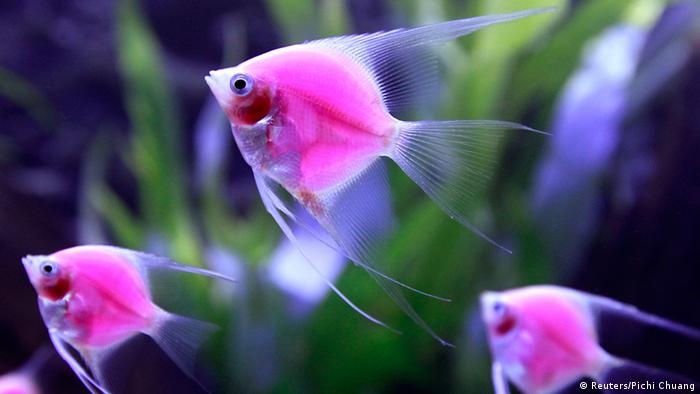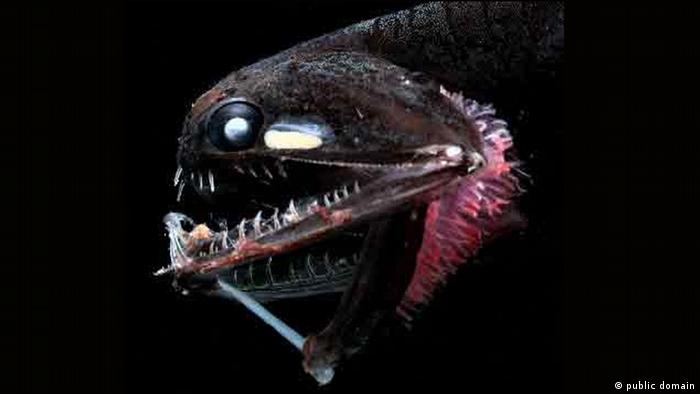Animals
A real rainbow fish!
This is a beautiful shimmering coat of scales? Mother nature had to do with this just a little: researchers have created the colorful fish in the laboratory, however, for ornament.
-

In the name of research
The American scientists have changed the fish in the laboratory by genetic engineering so that it appears in the most dazzling colors. The colors arising by chance, by red, green and blue fluorescent proteins.
-

Bright colors for the Aquarium
Otherwise this small comrades: On the Taiwan Aquarium Expo 2014 in Taipei, there were, among other things, these fish: Pterophyllum Scalare. They have been genetically bred so that they Shine. But not all of the fish, which develop their own luminosity, caused by the human hand. In nature, there are many other examples of luminous animals.
-

Light in the underwater world
The luminous jellyfish lights up when it is mechanically irritated, for example by water turbulence. The expert speaks of bioluminescence, the ability to generate self or with the help of bacteria light. This includes, especially, many sea animals are capable of.
-

Cause of sea glow
Unicellular organisms can produce light, like this Dinoflagellat. He is part of the marine plankton. Deformations of the cell membrane, by breaking waves or fast-swimming fish the lights. Thus, the single-cell predators confuse you.
-

Radiant Rear Part
The best-known example of luminous animals, the fireflies are. They produce in their light organ, the substance Luciferin and allow oxygen to react. In the subsequent light reaction. Males and females communicate through the light signals.
-

Light in the deep sea
Also, many deep sea fish have light organs. This deep sea hatchet fish. Some of the deep sea produce light residents to Orient yourself in the eternal darkness better. Other to lure prey.
-

On an unusual wave length
Also Photostomias from the family of the revelation of the dragon fish light. The deep-sea fish has light organs behind the eyes, which emit red light, one for marine organisms, unusual color. Other sea creatures are not able to perceive the light signals of this species.
-

Green with genetic engineering
Mice do not light normally. But in the laboratory we can change that. Researchers can bring the animals to, in their cells, the green fluorescent Protein. This protein occurs naturally in some species of Jellyfish. Under blue light, the entire mouse does not light up then green – only the fur.
-

All the animals and colors
Theoretically, all animals with genetic engineering to glow. A research Institute in Uruguay, created for example, these lambs: they glow yellow when they are irradiated with UV-light.
Author: T. Oelmaier / B. Osterath
-

In the name of research
The American scientists have changed the fish in the laboratory by genetic engineering so that it appears in the most dazzling colors. The colors arising by chance, by red, green and blue fluorescent proteins.
-

Bright colors for the Aquarium
Otherwise this small comrades: On the Taiwan Aquarium Expo 2014 in Taipei, there were, among other things, these fish: Pterophyllum Scalare. They have been genetically bred so that they Shine. But not all of the fish, which develop their own luminosity, caused by the human hand. In nature, there are many other examples of luminous animals.
-

Light in the underwater world
The luminous jellyfish lights up when it is mechanically irritated, for example by water turbulence. The expert speaks of bioluminescence, the ability to generate self or with the help of bacteria light. This includes, especially, many sea animals are capable of.
-

Cause of sea glow
Unicellular organisms can produce light, like this Dinoflagellat. He is part of the marine plankton. Deformations of the cell membrane, by breaking waves or fast-swimming fish the lights. Thus, the single-cell predators confuse you.
-

Radiant Rear Part
The best-known example of luminous animals, the fireflies are. They produce in their light organ, the substance Luciferin and allow oxygen to react. In the subsequent light reaction. Males and females communicate through the light signals.
-

Light in the deep sea
Also, many deep sea fish have light organs. This deep sea hatchet fish. Some of the deep sea produce light residents to Orient yourself in the eternal darkness better. Other to lure prey.
-

On an unusual wave length
Also Photostomias from the family of the revelation of the dragon fish light. The deep-sea fish has light organs behind the eyes, which emit red light, one for marine organisms, unusual color. Other sea creatures are not able to perceive the light signals of this species.
-

Green with genetic engineering
Mice do not light normally. But in the laboratory we can change that. Researchers can bring the animals to, in their cells, the green fluorescent Protein. This protein occurs naturally in some species of Jellyfish. Under blue light, the entire mouse does not light up then green – only the fur.
-

All the animals and colors
Theoretically, all animals with genetic engineering to glow. A research Institute in Uruguay, created for example, these lambs: they glow yellow when they are irradiated with UV-light.
Author: T. Oelmaier / B. Osterath
These fish would probably call many Aquarium owners like your Self, because the dazzling guy steals probably easily all other ornamental fish in the Show. But no, with this fish, scientists have a new Nemo, or Fabius (two famous fishy Comic book heroes) created with it, you have something completely different: research!
The Team of Chen-Hui Chen, and Kenneth Poss of Duke University in Durham, Carolina, want to understand using the rainbow fish, and how different cells work in the case of an injury and the skin heals. For this, they did it with genetic methods in the laboratory.
Every single skin cell of the animal illuminated in a different color. Especially good can be seen under the microscope (see picture). Here hundreds of colorful polka dots strung together. The effect is rich in the smallest fin tip, the researchers explain in the journal “Development Cell”.

Looking at the fish under the microscope, with rows of hundreds of colorful polka dots
Due to the many different colors you can keep track of the smallest cell changes over days and weeks. “Before we can understand tissue regeneration fully, we must be able to track what each individual cell does,” says Poss. The method is called “Skinbow”. You should be a pioneer for the research: In a single step, hundreds or thousands of cells in a regenerating, you can make fabric visible.
Red, green, blue cells
The different colors arise by chance, by red, green and blue fluorescent proteins, the researchers write in their work. More than 70 clearly distinguishable color tones come together – confusion – according to the researchers. The colors were formed only in the outermost layer of the skin, remain during the entire life time of the respective cell.
In addition to the laboratory fish, the scientists developed a new Software, with the help of the image series can be evaluated. So you can analyse each cell on the basis of their own biography. Movements to be covered, such as size and shape changes and other reactions to a skin injury.
Rainbow for brain and skin
Actually, the technique was developed called the individual neurons in the brain to be stained, yet “Brainbow”. Now the System for more sophisticated monitoring is designed to Supplement the possibilities still further, and with other imaging techniques can also be combined.
hf/fs (dpa)









